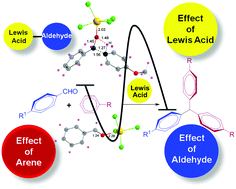Triggering the approach of an arene or heteroarene towards an aldehyde via Lewis acid–aldehyde communication†
Abstract
The present work reports a combined experimental/computational study of the Lewis acid promoted hydroxyalkylation reaction involving aldehyde and arene/heteroarene and reveals a mechanism in which the rate determining aldehyde to alcohol formation via a four-member cyclic transition state (TS) involves a transfer of hydrogen from arene/heteroarene C–H to aldehyde oxygen with the breaking of the C–H bond and formation of C–C and O–H bonds. The effect of different Sn(IV) derivatives on the hydroxyalkylation reaction from different in situ NMR and computational studies reveals that although the exergonic formation of the intermediate and its gained electrophilicity at the carbonyl carbon drive the reaction in SnCl4 compared to other Sn(IV) derivatives, the overall reaction is low yielding because of its stable intermediate. With respect to different aldehydes, LA promoted hydroxylation was found to be more feasible for an electron withdrawing aldehyde compared to electron rich aldehyde because of lower stability, enhanced electrophilicity gained at the aldehyde center, and a lower activation barrier between its intermediate and TS in the former as compared to the latter. The relative stability of the LA–aldehyde adduct decreases in the order SnCl4 > AlCl3 > InCl3 > BF3 > ZnCl2 > TiCl4 > SiCl4, while the activation barrier (ΔG#) between intermediate and transition states increases in the order AlCl3 < SnCl4 < InCl3 < BF3 < TiCl4 < ZnCl2 < SiCl4. On the other hand, the activation barriers in the case of different arenes/heteroarenes are in the order of indole < furan < anisole < thiophene < toluene < benzene < chlorobenzene < cyanobenzene, which suggests a facile reaction in the case of indole and the most difficult reaction in the case of cyanobenzene. The ease of formation of the corresponding diaryl methyl carbocation from the alcohol–LA intermediate is responsible for the determination of the undesired product and is found to be more viable in the case of strong LAs like AlCl3, InCl3 and SnCl4 because they have negative free energy of formation (ΔG) for alcohol to the corresponding diaryl methyl carbocation.


 Please wait while we load your content...
Please wait while we load your content...